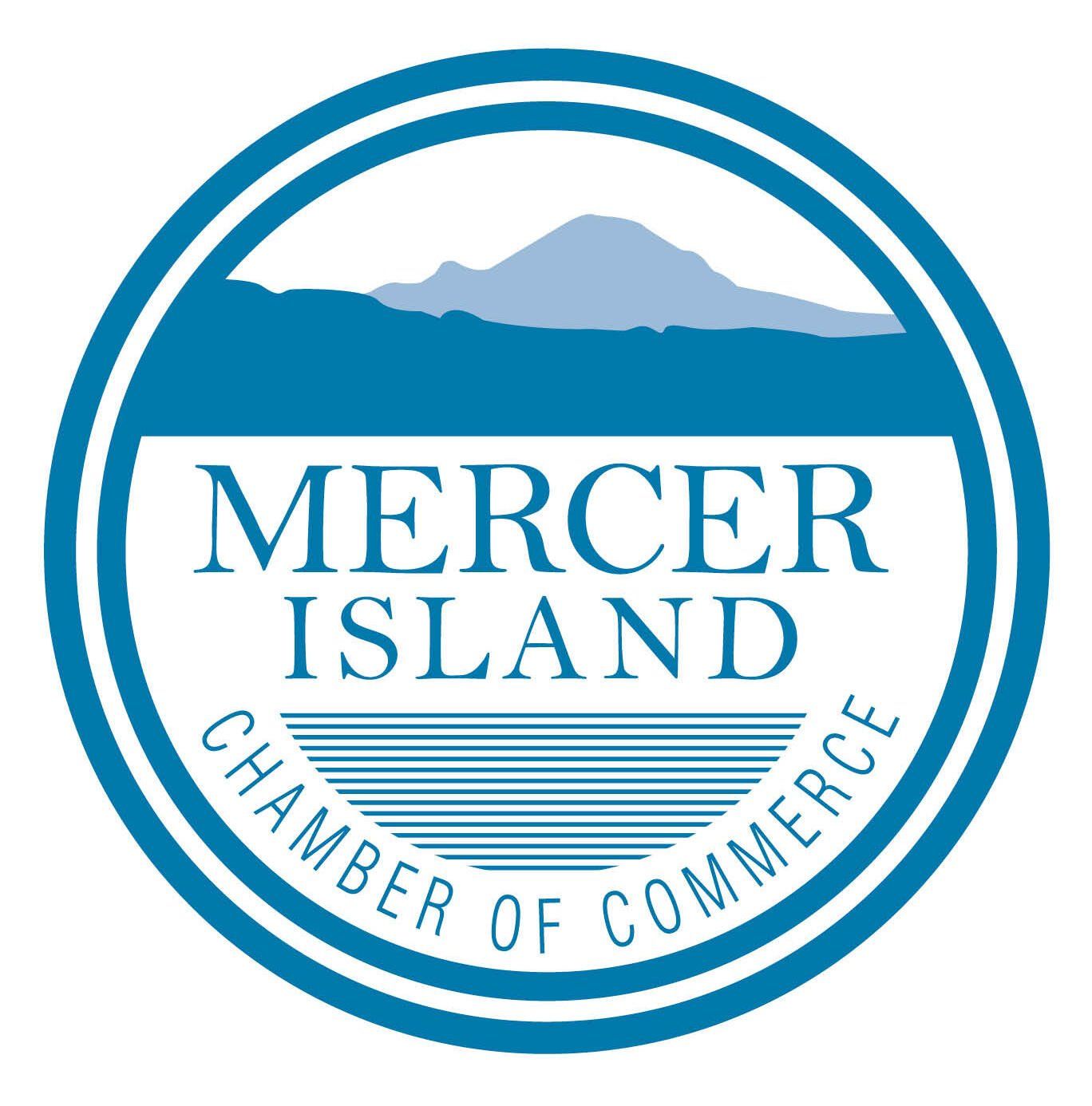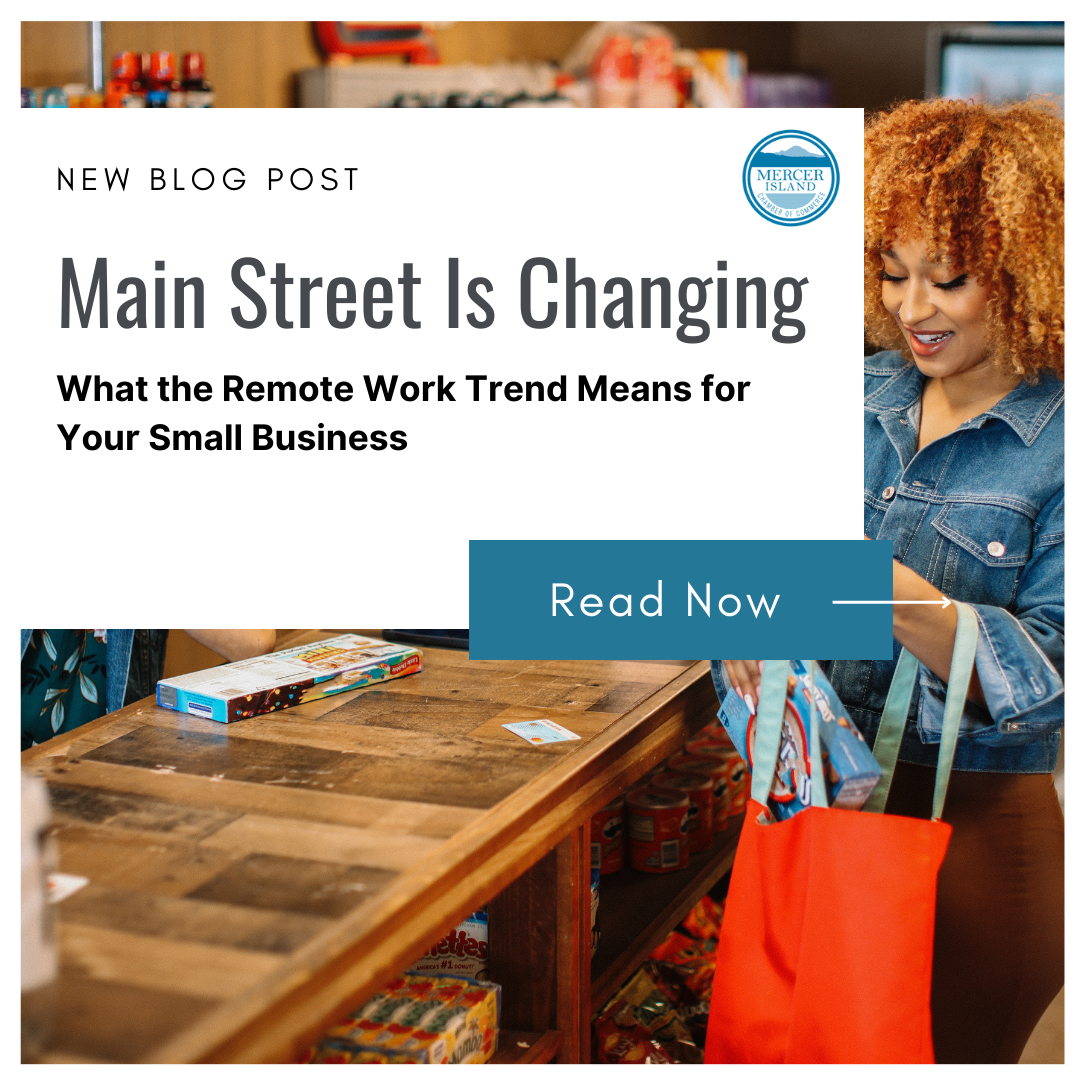Mercer Island
Chamber of Commerce
Building a stronger Mercer Island through business advocacy, support and development.
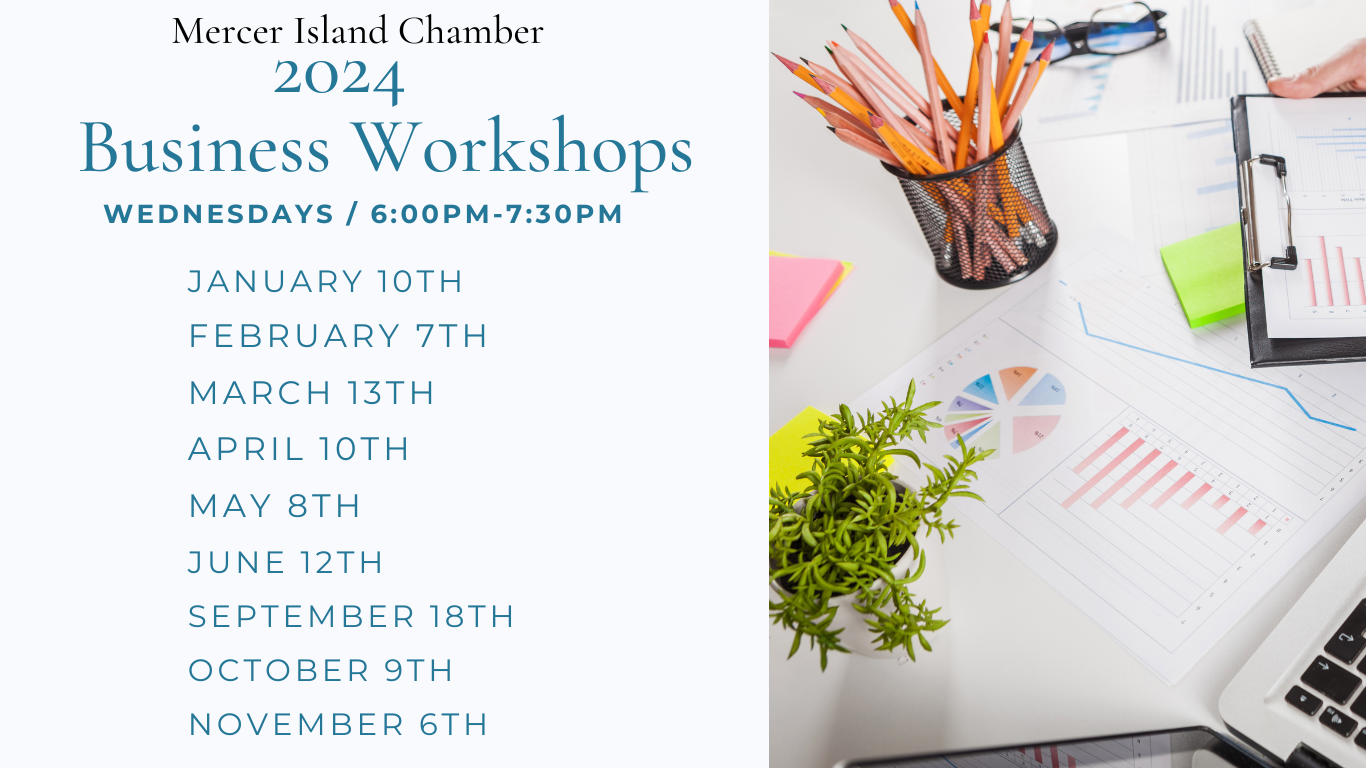
Slide title
Write your caption hereButton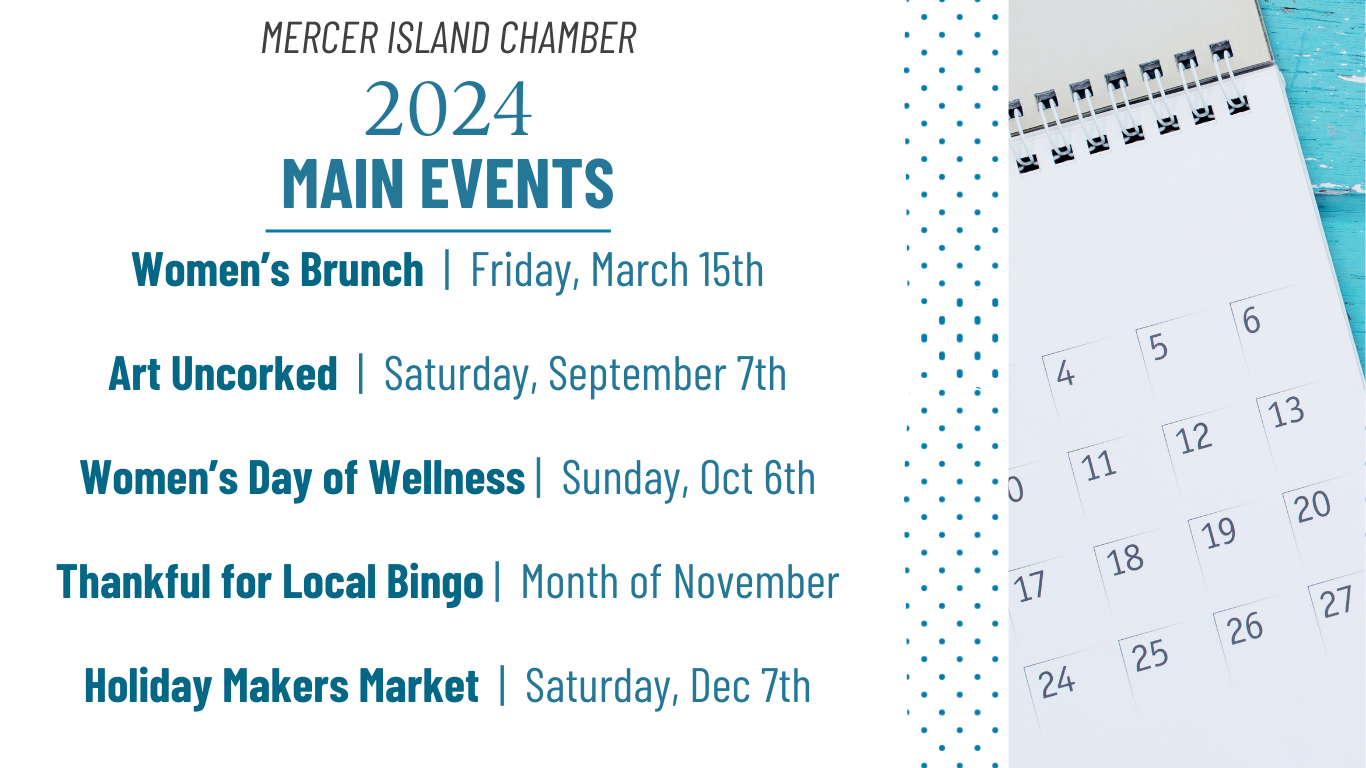
Slide title
Write your caption hereButton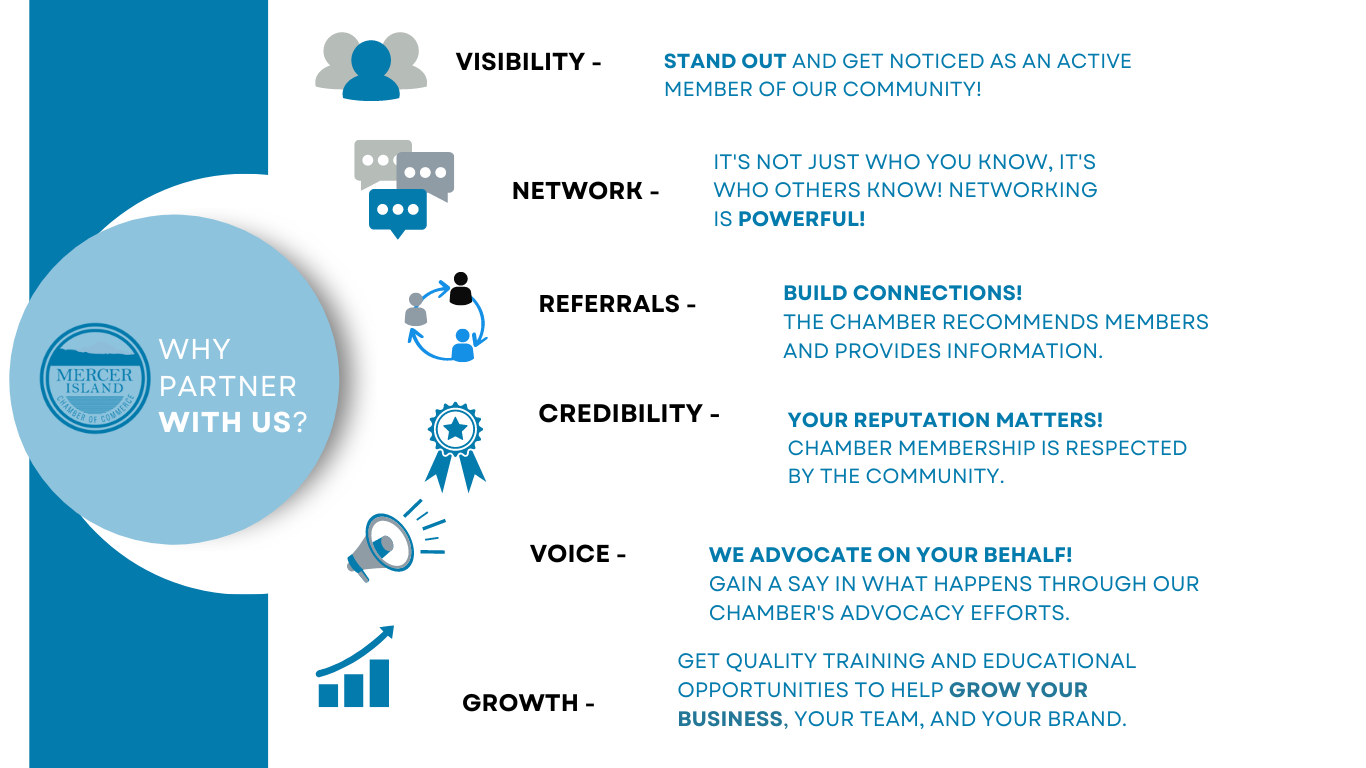
Slide title
Write your caption hereButton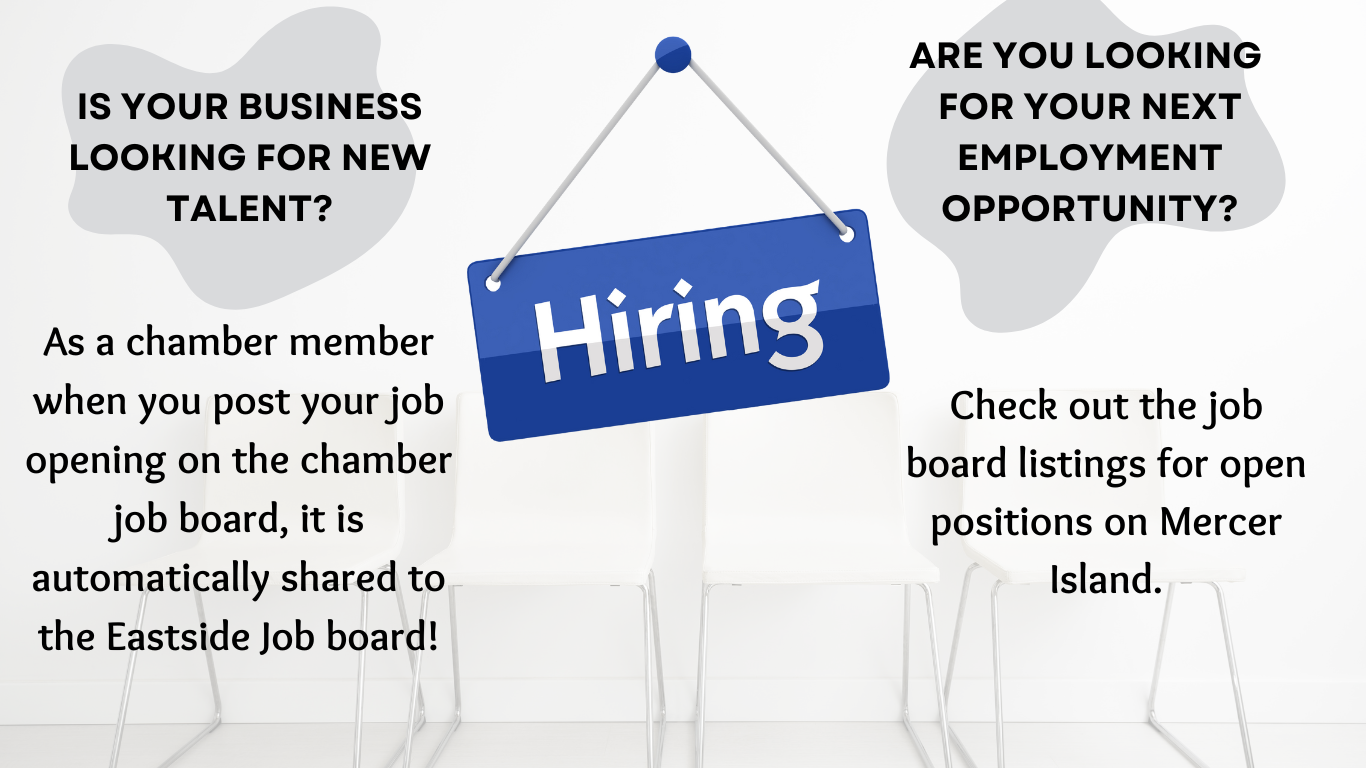
Slide title
Write your caption hereButton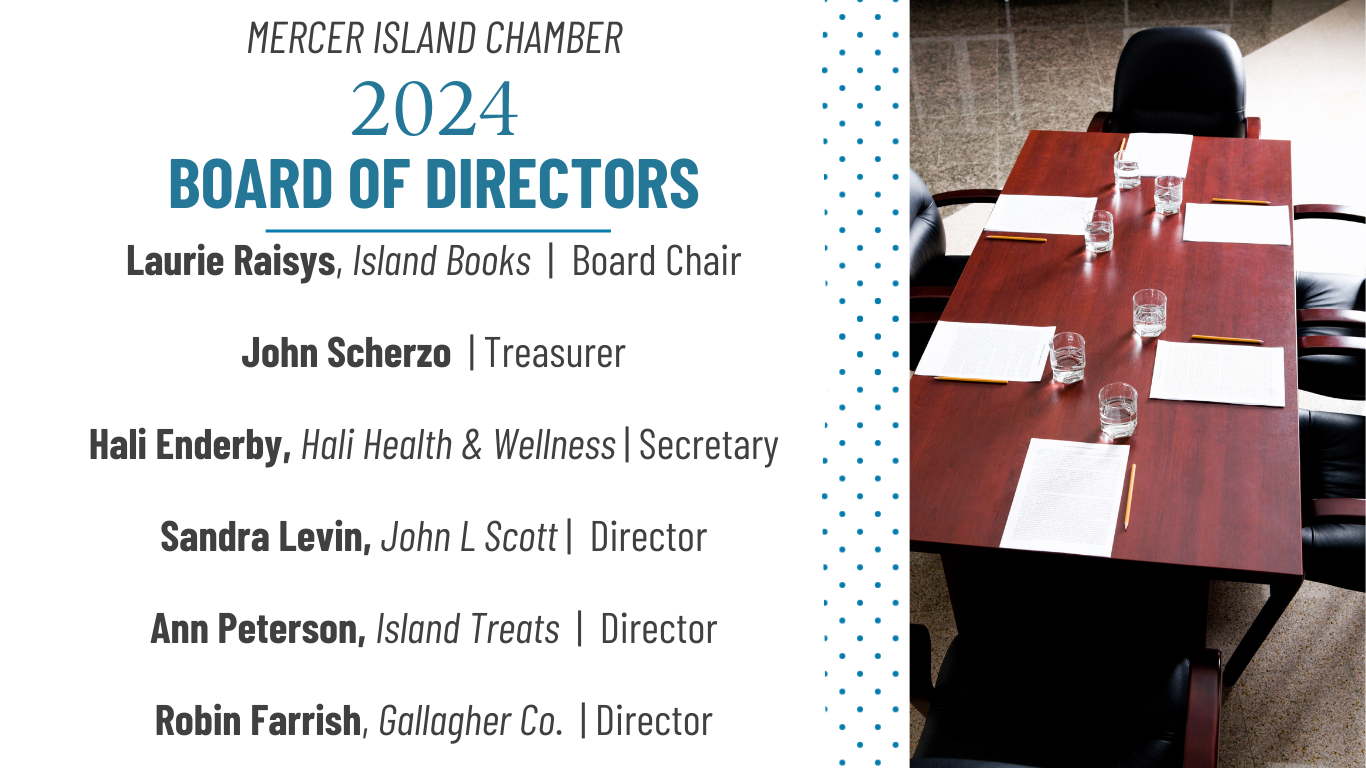
Slide title
Write your caption hereButton
MERCER ISLAND
CHAMBER OF COMMERCE
Key Events Highlight
Checkout our upcoming events and learn more about the Chamber's activities and plans.
Promote the economic vitality of Mercer Island through advocacy, leadership and community building events ♦ Provide referral and networking opportunities which facilitate development of strategic partnerships between businesses ♦ Publish a newsletter of Chamber and community news ♦ Produce community events that bring people and businesses to the island ♦ Serve as information center, offering maps and demographic information ♦ Recognize achievements of the business community ♦ Provide advertising and sponsorship opportunities ♦ Introduce new businesses to the community
Front Door to Mercer Island
Founded in 1946, the Mercer Island Chamber of Commerce has a long history of providing member advocacy and promotion, education resources and networking opportunities.
For Mercer Island Businesses
Representing a diverse collection of businesses, we work in partnership with our community and local government to help our members advance, grow and thrive. Through business education, networking, community events, advocacy and representation, the Mercer Island Chamber is committed to helping each member grow and prosper.
"Working with us opens an enormouse opportunity of growth"
Newest Members
Latest Business Blog Post

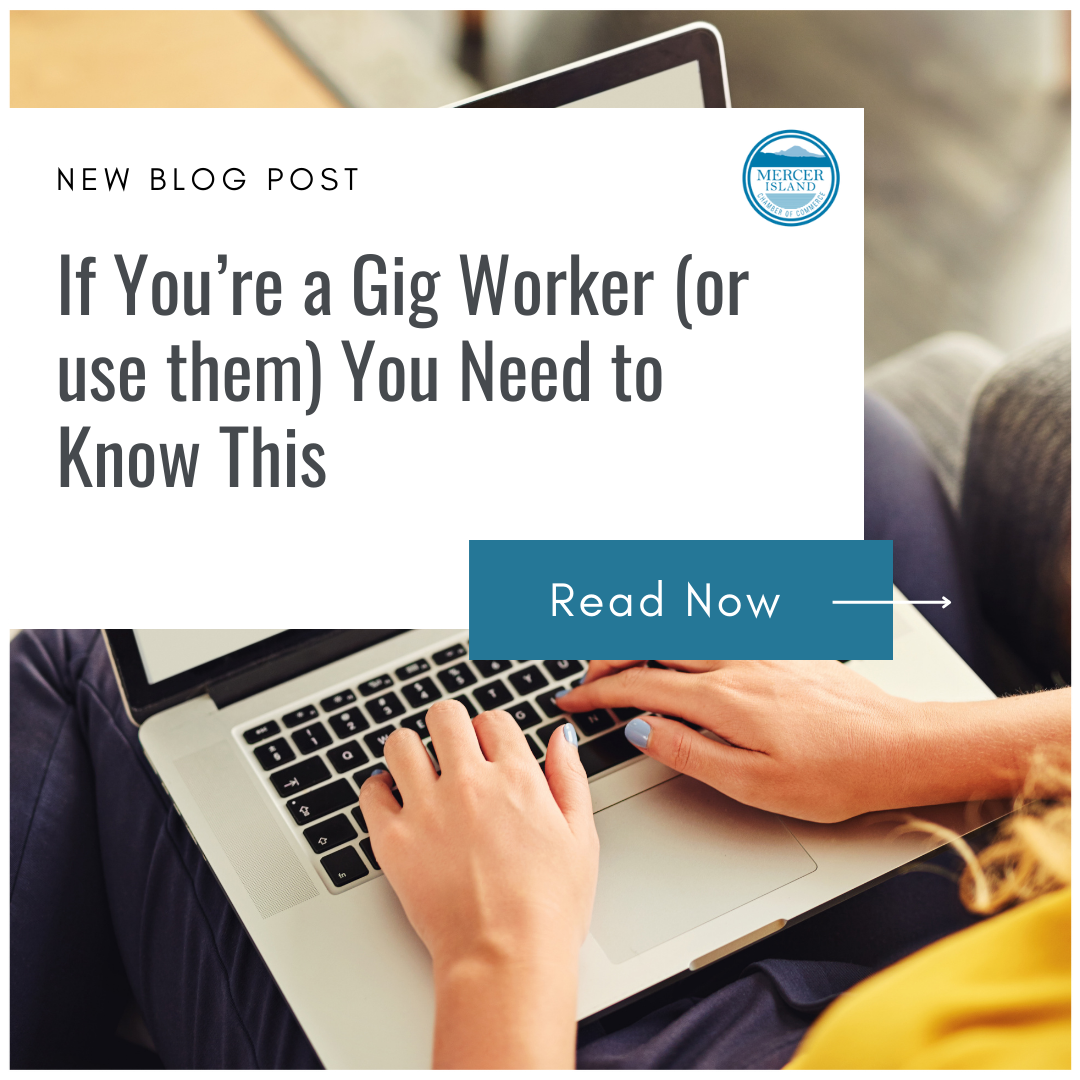
Join Today!
Your Business Advocate, Professional Resource Center, Community Connector, Network Builder!
Stay in touch with us on
Instagram!
-
This week on the blog, If You're a Gig Worker (or use them) You Need to Know This If you’re a gig worker, or you use them in your business, it’s important that you are aware of recent legislation that went into effect this month. What Is a Gig Worker? A gig worker (independent contractor, freelancer, or contingent worker) is someone who works on a temporary, flexible basis, often for multiple clients or companies. They perform specific tasks, projects, or assignments for a predetermined period, rather than being employed full-time by a single employer. The number of gig employees has grown exponentially over the past few years. In 2024, it’s expected there will be 76.4 million people working as freelancers and indie professionals). These people work in a variety of industries including ride-hailing (Uber, Lyft, etc.), food delivery, freelance writing, graphic design, consulting, and others. Click the link in our bio to continue reading on our website.Button
-
Join us and build new connections personally and professionally at our March After Hours at MIVAL Gallery. Thursday, March 28th 5:00-6:30pm Enjoy lite bites, refreshments, and connections. Free to attend. Open to all. You do not need to be a chamber member to attend. It is a great opportunity to learn more about the chamber, Mercer Island business community and have fun. Click the link in our bio to register. #mercerisland #mercerislandchamber #businessnetworking #growyourbusiness #smallbusiness #supportsmallbusiness #seattle #networkingButton
-
It's Friday, so what better day to celebrate International Goof Off Day! Take an extra break today and HAVE FUN! #havefun #mercerisland #mercerislandchamber #goofoff #justthisonce #business #workflow #havefunatworkButton
-
The 2024 Washington State legislative session was a short session this year, which means it lasted for just 60 days and moved at a rapid pace as legislators worked diligently to pass bills and budgets and end on time. East King Chamber's Coalition Session Report is now available on the Chambers Coalition Website. Click the link in our bio to read up on the session report, and bills status report. #mercerisland #mercerislandchamber #legislation #advocacy #smallbusinesssupport #businessfriendly #waButton
-
We are thrilled to continue our Business Workshop series April 10th. Email Marketing 101 - Foundations & Principles It’s all too common for business owners to miss out on sales because of ineffective–or non-existent–email marketing. Meaning you’re actually losing money if you don’t have the right email flows automated and on-point newsletter campaigns rolling out to your subscribers. Now’s the time to build a marketing channel that you own so you can grow your bottom line and build an engaged community of customers with you for the long haul. Molly, the owner of Acorn Digital Strategy, works with six and seven-figure businesses to increase brand awareness, improve customer loyalty, generate leads, and drive company revenue through strategic email marketing. During the Email Marketing 101 workshop, she’ll help you see where email marketing will fit into your sales funnel, how you can monetize your email list effectively, and what small steps you can take to get started on your email marketing journey as soon as you walk out the door. This workshop will focus on teaching business owners (selling products or services) how to build an effective email marketing strategy and the industry best practices you won’t find on Google. Be sure to also register for part two, where we’ll dig deeper into automation, campaign messaging strategy, data-driven decision-making, and more. Click the link in our bio to sign up now! #mercerisland #mercerislandchamber #businessworkshop #smallbusinesssupport #marketing #emailmarketing #grow #smallbiztipsButton
-
“Don’t follow the crowd, let the crowd follow you.” — Margaret Thatcher #insprie #womenleaders #mercerisland #mercerislandchamber #quote #leader #womenempowermentButton
-
Are you joining us for our next After Hours? Excited to be with our After Hosts @mivalgallery ! Open to everyone, After Hours offers connections and fun! Click the link in our bio to register today. #networking #seattle #mercerisland #mercerislandchamber #afterhours #businessButton
-
Happy St. Patrick's Day! Who's wearing green today? #mercerisland #mercerislandlife #mercerislandliving #stpatricksdayButton
-
We are excited to celebrate our 2nd annual Champions of Change Women's Brunch tomorrow. If you have not registered, do not wait as there are only a few tickets remaining. Join us for a delicious brunch, connect with like-minded women, chat with our amazing sponsors, and be inspired by our speaker, Linda Hoffner. Open to everyone. Click the link in our bio to register. #women #mercerisland #womenshistorymonth #empower #inspire #mercerislandchamber #brunchButton
-
Want to be in the know on what’s happening in the community? Then sign up for our weekly newsletter! From chamber events, to member announcements, activities and new happenings get the news delivered yo your inbox each week. Click through link in our bio to sign up now. #mercerisland #mercerislandchamber #newsletter #businesstips #businessnews #communityButton
-
"The future belongs to those who believe in the beauty of their dreams." -Elenaor Rossevelt #womensupportingwomen #empowerwomen #womenshistorymonth #inspire #mercerisland #mercerislandchamberButton
-
Are you registered to attend this Friday's Champion's of Change Women's Brunch? You could win 4 tickets to Cubs @ Mariners game on Saturday, April 13th at 6:40pm courtesy of @pugetsoundenergy! Click the link in our bio to get your ticket to the brunch, and your chance to win. #mercerisland #mercerislandchamber #womenempowerment #womenboss #baseball #smallbusiness #womensbusinessButton
-
Every year, on the second Sunday of March at 2 a.m., daylight savings time begins. Daylight savings allows us to have evenings with more sunlight - don't forget to set your clocks and "spring forward"! #mercerisland #mercerislandwa #mercerislandlife #mercerislandhomes #mercerislandliving #daylightsavingsButton
-
Happy weekend! #quotes #inspiration #mercerisland #mercerislandwa #mercerislandlife #mercerislandlivingButton
-
Happy International Women’s Day! Celebrate with us next Friday at the Champion’s Change Women’s Brunch! You’ll get to enjoy a delicious brunch buffet, connect with like-minded women, visit with some amazing sponsor booths, and hear from our special guest speaker: Linda Hoffner! Click the link in our bio to register! #women #mercerisland #mercerislandchamber #womensupportingwomen #brunch #womenseventButton
-
This week on the chamber blog: Turning Your Passion into Profit: A Short Guide to Transforming Your Hobby into a Business Whether it’s part of a work/life balance personal initiative, an idea to follow your bliss, or you simply want to change things in your life, if you have a hobby you want to turn into a business, we have some advice for you. It can be a huge leap of faith moving from a steady paycheck to relying on others to buy from you. But it can be done successfully if you do your homework first. Going into business for yourself has the potential for personal and financial fulfillment. But it comes at great risk. For risk-averse people, this is the first challenge in going from hobby to business. As writer, speaker, and consultant Tim Ferriss wrote in his book The 4-hour Workweek, “People will choose unhappiness over uncertainty.” If you want to turn your hobby into a business, you’ll want to minimize the uncertainty. And that comes through planning. Click the link in our bio to continue reading. #smallbusiensstips #blog #mercerislandchamber #mercerislandButton
-
Have you signed up for our next Business Workshop? Click the link in our profile to save your seat. Space is filling up quickly and is limited. Join Katie Miller form KM Marketing Services as she leads you through a workshop on brand basics. Course Highlights: Designing Your Brand Identity: Learn the principles of effective brand design, including logo creation, color schemes, and visual elements that reflect your brand personality. Understand the psychology behind design choices and how they influence consumer perceptions. Building a Cohesive Brand Architecture: Dive into the strategic planning of your brand architecture, ensuring consistency across all touchpoints. Explore the importance of brand elements, from typography to imagery, in maintaining a cohesive and memorable brand image. Implementation Strategies for Success:Gain insights into practical implementation strategies that align with your business goals. Explore how to integrate your brand seamlessly across various channels, including digital platforms, print materials, and physical spaces. Storytelling Techniques for Brand Narrative: Understand the art of crafting a compelling brand story that resonates with your target audience.Learn how to communicate your brand’s values, mission, and unique selling propositions through narrative techniques Workshops are open to everyone. #mercerisland #mercerislandchamber #businesstips #workshop #smallbusiness #learntogether #growyourbusinessButton
-
Shopping local keeps the community you love to live in vibrant and supports your neighbors. Shopping local also sends the message to any business that might be looking for a home, that your city is a great place to have a business. #shoplocal #supportlocal #buildcommunity #economy #mercerisland #mercerislandchamberButton
-
Happy Sunday! #quotes #quotestags #quotesdaily #mercerisland #mercerislandwa #mercerislandlife #mercerislandlivingButton
-
Two weeks away from our 2nd annual Champions of Change Women’s Brunch! Join us for delicious brunch buffet, connect with like-minded women, visit with some amazing sponsor booths, and hear from our special guest speaker: @linda.hoffner ! A huge thank you to our sponsors. Click the link in our bio to get your tickets. #mercerisland #mercerislandchamber #womensbrunch #empowerwomen #bossbabes #womeninbusinessButton
-
Happy Leap Day! What fun things did you do to celebrate the day? #mercerisland #mercerislandchamber #leapday #leapofkindnessday #extradayButton
-
Just one week away from kicking off this year’s Coffee and Conversation series with Mayor Niece and Deputy Mayor Rosenbaum on Wednesday, March 6th at 10am. This member only event brings local leaders and chamber businesses together for an opportunity to have casual conversations about the issues hat are important to chamber members. Join us at the community center for coffee, connections, and conversations. Registration is required, as space is limited for this event Must be a current chamber member in good standing. #mercerislandchamber #mercerisland #mercerislandliving #chamber #coffeeandconversation #businessleaders #letstalk #changingthegameButton
-
This week on the blog, Become an Addictive Brand. Does your morning begin post coffee? If so, then you know the importance of that routine (and caffeine addiction). Your morning just isn’t the same without it. You can create the same addiction to your business. It just requires a more carefully created artifice or brand. Without the help of caffeine or other addictive substance, you’ll need to use marketing and a persona that draws people in and makes them want to be a part of your business. Whether you are a company of one or 100, there are ways to help customers feel a “need” for you. You just have to find the right combination of desires and attitudes. How to Become an Addictive Brand At the risk of pulling a bait and switch, I want to be clear that the idea is not to make EVERYONE addicted to you, but rather, your ideal customer. That said, tailor the suggestions below to appeal to your demographic. Let’s look at how others have done it successfully. Click the link in our bio to continue reading. #mercerisland #mercerislandchamber #blog #businesstips #businessblog #brandingButton
-
Two weeks away from our next Business Workshop, and already half full! Don’t wait to register. Click the link in our bio. Join Katie Miller form KM Marketing Services as she leads you through a workshop on brand basics. Course Highlights: Designing Your Brand Identity: Learn the principles of effective brand design, including logo creation, color schemes, and visual elements that reflect your brand personality. Understand the psychology behind design choices and how they influence consumer perceptions. Building a Cohesive Brand Architecture: Dive into the strategic planning of your brand architecture, ensuring consistency across all touchpoints. Explore the importance of brand elements, from typography to imagery, in maintaining a cohesive and memorable brand image. Implementation Strategies for Success:Gain insights into practical implementation strategies that align with your business goals. Explore how to integrate your brand seamlessly across various channels, including digital platforms, print materials, and physical spaces. Storytelling Techniques for Brand Narrative: Understand the art of crafting a compelling brand story that resonates with your target audience.Learn how to communicate your brand’s values, mission, and unique selling propositions through narrative techniques Workshops are open to everyone. Registration is required as space is limited. #mercerisland #mercerislandchamber #businesstips #workshop #smallbusiness #learntogether #growyourbusinessButton
-
Last Tuesday the East King Chamber Coalition had Chamber Day in Olympia. Over 25 chamber execs and chamber business representatives met with 24 legislators to advocate for business friendly legislation. We also heard from Association of Washington Business (AWB) Dave Mastin, Vice President of Government Affairs at AWB, Jan Himebaugh from the Building Industry Association of Washington (BIAW) and Samantha Louderback from the Washington Hospitality Association (WHA) on their groups advocacy efforts. You can learn more about the East King Chambers Coalition as well as stay up to date during the legislation session with weekly updates, and more at the coalition website. Click the link in the bio to learn more. A huge thank you to the Public Policy team at the Bellevue Chamber for organizing the day. #mercerislandwa #mercerislandchamber #chamber #advocacy #olympiaButton
-
Thank you for supporting Mercer Island businesses! Let us know your local favorites in the comments: #mercerislandchamber #supportlocal #mercerisland #localfavoriteButton
-
Welcome to the Chamber! As our list of amazing members grows, reach out to learn more about joining benefits including: - Educational Monthly Luncheons, Workshops, & Webinars - Social Media exposure - Monthly After Hours - Professional Networking Events #mercerislandchamber #chamber #businesssupport #growyourbusiness #supportlocalButton
-
Have you been thinking of starting your own business? Maybe you have the bones but need more direction? Or are you an established business looking to grow? Did you know there are tons of resources and people available to assist you with any and all of your questions? Check out this list of resources we have gathered for ease of access. English is not your first language? No problem many resources offer language services Women owner? There are many resources to get you started. Need capital? No problem. From traditional financing options to non-traditional, there are small business resources ready to help. #mercerislandchamber #businessresources #getstarted #smallbusinessButton
-
#mercerisland #mercerislandwa #mercerislandchamber #mindset #inspiration #quotes #mercerislandchamberofcommerce #chamber #business #shoplocalButton
-
Do you have a pet? Comment their name down below! #mercerisland #mercerislandwa #mercerislandchamber #mercerislandchamberofcommerce #mercerislandliving #chamber #business #shoplocal #pets #treatsButton
-
Will we see you tomorrow? Don’t miss our first Network Together After Hours with Bellevue Chamber at @yellowwoodacademy Expand your professional network, enjoy lite bites and refreshments. #mercerisland #mercerislandlife #mercerislandchamber #chamber #networking #businessnetworkingButton
-
We are thrilled to kick off this year’s Coffee and Conversation series with Mayor Niece and Deputy Mayor Rosenbaum on Wednesday, March 6th at 10am. This member only event brings local leaders and chamber businesses together for an opportunity to have casual conversations about the issues hat are important to chamber members. Join us at the community center for coffee, connections, and conversations. Registration is required, as space is limited for this event Must be a current chamber member in good standing. #mercerislandchamber #mercerisland #mercerislandliving #chamber #coffeeandconversation #businessleaders #letstalk #changingthegameButton
-
Whether looking for financing options for your first business venture, or looking for options to expand your business, Mercer Island banks are a great resource and are there to answer your questions. #mercerisland #mercerislandchamber #banking #financial #buildingbusinessButton
-
Get ready to network, learn, and grow with other amazing women at our Annual Champions of Change: Women’s Business Brunch on Friday, March 15th, 2024 at the Mercer Island Community Center from 10:30 am to 12:30 pm. You’ll get to enjoy a delicious brunch graze buffet, connect with like-minded women, visit with some amazing sponsor booths, and hear from our special guest speaker: Linda Hoffner! Linda Hoffner is a General Manager at Wright Runstad & Company overseeing The Spring District development in the Bel-Red corridor of Bellevue. She oversees the operations of 1M SF of completed office and retail space leased to Meta, the Global Innovation Exchange, Deloitte, Catalyst, and Bellevue Brewing. Linda had the pleasure of serving as Mrs. Washington America 2020 supporting many organizations across the state during the global pandemic and continues to remain a mentor for women in the Washington America Pageants program. Linda was named one of Puget Sound Business Journal AND 425 Business Magazine’s ‘40 under 40’ for 2023. Linda is on the Board of Bellevue-based nonprofit Rainier Athletes and the Bellevue Chamber, while also engaging as an active member of the Transportation and Land Use committees within the Chamber and the Bellevue Downtown Association. Additionally, Linda serves as the CREW Network Seattle Chapter Programs Committee Chair and is a member of the Leadership Eastside cohort graduating in 2024. She has partnered with Habitat for Humanity Seattle-King County on many Women Build events and is a strong supporter of affordable housing efforts in King County. Head over to our bio and get your tickets today. Tickets are limited, so don’t delay. Open to all. #mercerisland #mercerislandliving #mercerislandchamber #chamber #ChampionsofChange #womensupportingwomen #business #businesswoman #inspriationButton
-
Join Katie Miller form KM Marketing Services for the last in our series with her as she leads you through a workshop on brand basics. Whether you are a startup defining your brand for the first time or an established business seeking a brand refresh, “Brand Basics” is your guide to crafting a brand that not only stands out but drives your ultimate success. Course Highlights: Designing Your Brand Identity: Learn the principles of effective brand design, including logo creation, color schemes, and visual elements that reflect your brand personality. Understand the psychology behind design choices and how they influence consumer perceptions. Building a Cohesive Brand Architecture: Dive into the strategic planning of your brand architecture, ensuring consistency across all touchpoints. Explore the importance of brand elements, from typography to imagery, in maintaining a cohesive and memorable brand image. Implementation Strategies for Success:Gain insights into practical implementation strategies that align with your business goals. Explore how to integrate your brand seamlessly across various channels, including digital platforms, print materials, and physical spaces. Storytelling Techniques for Brand Narrative: Understand the art of crafting a compelling brand story that resonates with your target audience.Learn how to communicate your brand’s values, mission, and unique selling propositions through narrative techniques Workshops are open to everyone. Registration is required as space is limited.Button
-
Join us for the first 5 Chamber Networking Breakfast for 2024. Enjoy lighting fast networking, breakfast and connections with exposure to 5 area chambers markets. Click the link in our bio. Registration closes next week. #mercerisland #mercerislandliving #mercerislandchamber #chamber #networkingButton
-
#mercerisland #mercerislandwa #mercerislandchamber #mercerislandchamberofcommerce #mercerislandliving #chamber #business #shoplocal #inspiration #quotes #mindsetButton
-
Just one week away from our first Network Together After Hours! Join us as we partner with Bellevue Chamber to amplify your impact in a joint after hours networking event. Bring your smile, your business card, and enjoy lite bites and refreshments while growing your professional circle. Open to all. Free to attend. You do not have to be a member, so it is a great way to see what the chamber is all about. Click the link in our bio to register as space is limited. #mercer #mercerisland #mercerislandliving #mercerislandchamber #chamber #bellevuechamber #networking #afterhours #growyourbusinessButton
-
Who’s ready for Valentine’s Day tomorrow?! 💙💙 Need a last-minute gift? Mercer Island is home to a variety of amazing stores for gift shopping! #mercerisland #mercerislandwa #mercerislandchamber #mercerislandchamberofcommerce #mercerislandliving #chamber #business #shoplocal #valentinesdaygifts #valentinesday #planButton
-
What is a Chamber of Commerce? While we often get asked this question, and we feel that a Chamber of Commerce is really a secret weapon for business growth, development and advocacy, that is not the text book answer. The Chamber of Commerce has the responsibility of enriching the economic well-being of its community. This is accomplished through promoting business growth and development; preserving the business system; amplifying a community through events and activations that promote business; providing access to educational programing and resources; and more. A Chamber of Commerce is primarily an organization of business and professionals who work together to make a community a better place to live and work. If you have interest in the economic well being of a community, than you should join forces with your Chamber of Commerce! Want to learn more? Contact us today! info@mercerislandchamber.com #mercerislandchamber #mercerisland #mercerislandliving #chamber #economics #businessdevelopment #letsgrow #businesssupportButton
-
Snacks ready? Drinks ready? Now, who are you cheering for? #mercerisland #chamber #mercerislandchamber #gameday #footballButton
-
Happy year of the Dragon! 恭喜發財! #mercerisland #mercerislandwa #mercerislandlife #mercerislandhomes #mercerislandliving #yearofthedragon #yearofthedragon🐉Button
-
Coffee and Conversations is back! We are thrilled to kick off this year's series with Mayor Niece and Deputy Mayor Rosenbaum on Wednesday, March 6th at 10am. This member only event brings local leaders and chamber businesses together for an opportunity to have casual conversations about the issues hat are important to chamber members. Join us at the community center for coffee, connections, and conversations. Registration is required, as space is limited for this event Must be a current chamber member in good standing. #mercerislandchamber #mercerisland #mercerislandliving #chamber #coffeeandconversation #businessleaders #letstalk #changingthegameButton
-
Valentine's Day is approaching us quickly....check out the shops on Mercer Island for some amazing gifts! Chocolate and flowers are a classic, but what kind of gifts do you like to give or receive? Comment down below! #mercerisland #mercerislandwa #mercerislandliving #mercerislandchamberofcommerce #mercerislandchamber #chamber #business #local #shoplocal #valentinesdaygift #valentinesdaygifts #chocolate #flowersButton
-
Mark your calendars to join us as we partner with Bellevue Chamber to amplify your impact in a joint after hours networking event. Bring your smile, your business card, and enjoy lite bites and refreshments while growing your professional circle. Open to all. Free to attend. You do not have to be a member, so it is a great way to see what the chamber is all about. Click the link in our bio to register as space is limited. #mercer #mercerisland #mercerislandliving #mercerislandchamber #chamber #bellevuechamber #networking #afterhours #growyourbusinessButton
-
Comment down below some of your favorite toppings for frozen yogurt! #mercerisland #mercerislandwa #mercerislandliving #mercerislandchamber #mercerislandchamberofcommerce #chamber #business #shoplocal #frozenyogurt #treatsButton
-
This week on the chamber blog, Transform Your Workspace for Productivity and Success Creating the right office space is something you embark on every time you’re procrastinating. It can be a time suck or a filler. But investing time in establishing the right work space can improve your productivity, creativity, and organization, as well as make you more successful. Whether you believe in Feng Shui or not, you can transform your workspace into a harmonious and productive haven that will help you achieve more in the time it takes to watch your favorite TV show. Click the blog link in our bio to continue reading. #mercerislandchamber #mercerisland #mercerislandliving #chamber #businessblog #businesstipsButton
-
Get ready to network, learn, and grow with other amazing women at our Annual Champions of Change: Women’s Business Brunch on Friday, March 15th, 2024 at the Mercer Island Community Center from 10:30 am to 12:30 pm. You’ll get to enjoy a delicious brunch graze buffet, connect with like-minded women, visit with some amazing sponsor booths, and hear from our special guest speaker: Linda Hoffner! Linda Hoffner is a General Manager at Wright Runstad & Company overseeing The Spring District development in the Bel-Red corridor of Bellevue. She oversees the operations of 1M SF of completed office and retail space leased to Meta, the Global Innovation Exchange, Deloitte, Catalyst, and Bellevue Brewing. Linda had the pleasure of serving as Mrs. Washington America 2020 supporting many organizations across the state during the global pandemic and continues to remain a mentor for women in the Washington America Pageants program. Linda was named one of Puget Sound Business Journal AND 425 Business Magazine’s ‘40 under 40’ for 2023. Linda is on the Board of Bellevue-based nonprofit Rainier Athletes and the Bellevue Chamber, while also engaging as an active member of the Transportation and Land Use committees within the Chamber and the Bellevue Downtown Association. Additionally, Linda serves as the CREW Network Seattle Chapter Programs Committee Chair and is a member of the Leadership Eastside cohort graduating in 2024. She has partnered with Habitat for Humanity Seattle-King County on many Women Build events and is a strong supporter of affordable housing efforts in King County. Head over to our bio and get your tickets today. Tickets are limited, so don't delay. Open to all. #mercerisland #mercerislandliving #mercerislandchamber #chamber #ChampionsofChange #womensupportingwomen #business #businesswoman #inspriationButton
-
This weekend is a great opportunity is shop small and support our local businesses! #mercerisland #mercerislandwa #mercerislandlife #mercerislandlivingButton
-
#mercerislandchamberofcommerce #mercerisland #mercerislandwa #mercerislandlife #mercerislandlivingButton
-
Networking Together After Hours is back for 2024. Mark your calendars to join us as we partner with Bellevue Chamber to amplify your impact in a joint after hours networking event. Bring your smile, your business card, and enjoy lite bites and refreshments while growing your professional circle. Open to all. Free to attend. You do not have to be a member, so it is a great way to see what the chamber is all about. Click the link in our bio to register as space is limited. #mercer #mercerisland #mercerislandliving #mercerislandchamber #chamber #bellevuechamber #networking #afterhours #growyourbusinessButton
-
Are you a dark chocolate or milk chocolate fan? Comment down below! #mercerisland #mercerislandwa #mercerislandliving #mercerislandchamber #mercerislandchamberofcommerce #local #business #chamber #darkchocolate #chocolateButton
-
Announcing your 2024 Chamber Board of Directors! Board Chair: Laurie Raisys, Island Books Treasurer: John Scherzo, Management Advisory Services Secretary: Hali Enderby, Hali Health & Wellness Director: Sandra Levin, John L Scott Director: Ann Peterson, Island Treats Director: Robin Farrish, Gallagher Co. If you see them around, say HI. Have a concern, let them know. Think the chamber is doing a great job, thank them. #MercerIsland #mercerislandwa #mercerislandliving #mercerislandchamber #chamber #boardofdirectors #businessleadersButton
-
This week on the blog: Get Over Your Fear of Video and onto YouTube! There’s an untapped goldmine out there for your business—YouTube. Beyond the fact that it is the second-largest search engine globally (behind its parent Google), YouTube offers a unique space for businesses to connect with their audience, showcase expertise, and build lasting relationships. It’s time to get over your fear of video and embrace the world of YouTube because it can significantly impact your business growth and reach. Head over to our website to continue reading. #mercerisland #mercerislandliving #mercerislandchamber #chamber #businesstips #businessblogButton
-
#mercerisland #mercerislandwa #mercerislandliving #mercerislandchamber #mercerislandchamberofcommerce #chamber #business #shoplocal #croissants #treatsButton
-
! EVENT IS FULL! If you would like to be added to the waitlist please email the office, info@mercerislandchamber.com In our 2nd workshop with Katie Miller form KM Marketing Services, you will gain practical insights and actionable strategies that will elevate your social media game. This class is designed to take you on a comprehensive journey through the world of social media, empowering you to be seen, connect effectively, and generate success for your business. Course Highlights: Strategic Social Media Deep Dive: Delve into the intricacies of major social media platforms and understand their unique landscapes. Visibility Strategies: Explore techniques for increasing visibility on social media. Effective Connection: Learn the art of building authentic connections on social media. Explore strategies for engaging with your audience, fostering meaningful conversations, and cultivating a community around your brand. Visual Storytelling Mastery: Explore the power of visual storytelling and learn how to leverage visuals to captivate your audience. Discover design principles, video strategies, and visual content trends that resonate in 2024. Success Metrics: Uncover key performance indicators (KPIs) and measurement tools to track your social media success. Learn how to analyze data to refine your strategy and achieve your business goals. Thank you to our workshop series partner, Kay Bank. Workshops are open to everyone. Registration is required as space is limited. Payment for guests (non-members attending) is due before the workshop. #mercerisland #mercerislandliving #mercerislandchamber #chamber #businessworkshop #businesstips #supportlocalButton
-
Comment your go-to brunch location on MI! #mercerisland #mercerislandwa #mercerislandlife #mercerislandhomes #mercerislandlivingButton
-
#valentinesday #mercerisland #mercerislandwa #mercerislandlife #mercerislandlivingButton
-
SAVE THE DATE! 2024 Art Uncorked planning is under way and we are thrilled to share this year's date, SATURDAY, September 7th! You heard that right, we are moving it to Saturday this year to give islanders even more opportunity to join in the fun and still enjoy Friday night lights. So mark your calendars now, and keep an eye out for tickets sales in July. We sold out last year, and are adding even more this year. ***** Interested in sponsoring this year? Email the office, info@mercerislandchamber.com to learn sponsorship levels.********** #mercerisland #mercerislandwa #mercerislandliving #mercerislandchamber #chamber #wineevents #wineo #cider #beer #musicButton
-
Support Local Business Online! ✅Follow their business page on social media 📲Comment/share their posts ⌨️Leave a review 📱Tag their business in your selfie or social media post 💻Purchase from their online store 🗣Tell your friends about them #supportlocal #shoplocal #mercerisland #mercerislandliving #mercerislandchamber #chamberButton
-
#mercerisland #mercerislandwa #mercerislandliving #mercerislandchamber #mercerislandchamberofcommerce #chamber #business #shoplocal #inspiration #inspirationalquote #mindsetButton
-
In our 2nd workshop with Katie Miller form KM Marketing Services, you will gain practical insights and actionable strategies that will elevate your social media game. This class is designed to take you on a comprehensive journey through the world of social media, empowering you to be seen, connect effectively, and generate success for your business. Course Highlights: Strategic Social Media Deep Dive: Delve into the intricacies of major social media platforms and understand their unique landscapes. Visibility Strategies: Explore techniques for increasing visibility on social media. Effective Connection: Learn the art of building authentic connections on social media. Explore strategies for engaging with your audience, fostering meaningful conversations, and cultivating a community around your brand. Visual Storytelling Mastery: Explore the power of visual storytelling and learn how to leverage visuals to captivate your audience. Discover design principles, video strategies, and visual content trends that resonate in 2024. Success Metrics: Uncover key performance indicators (KPIs) and measurement tools to track your social media success. Learn how to analyze data to refine your strategy and achieve your business goals. Thank you to our workshop series partner, Kay Bank. Workshops are open to everyone. Registration is required as space is limited. Payment for guests (non-members attending) is due before the workshop. #mercerisland #mercerislandliving #mercerislandchamber #chamber #businessworkshop #businesstips #supportlocalButton
-
This week on the chamber blog. 3 Copywriting Tips That AI Doesn't Use Recently an SEO expert who swore that search engines are biased against AI-written websites (websites that have not one word written by a human). He said AI-written websites are something search engines are discounting for (marking you down) because of the possibility of the sites being fake or holder sites. I can’t speak to the truth behind this but if you do still want to write some of your own copy, here are three copywriting tips you can implement today that AI isn’t using. Click the link in our bio to continue reading. #mercerisland #mercerislandliving #mercerislandchamber #chamber #businessblog #businesstipsButton
-
#mercerisland #mercerislandwa #mercerislandchamber #mercerislandchamberofcommerce #chamber #mercerislandliving #business #shoplocal #NationalPieDay #nationalpieday🥧 #pieButton
-
Shopping at one business might not change the world, but it could mean the world to that business owner. -Norma Davey #mercerisland #mercerislandwa #mercerislandliving #mercerislandchamber #supportlocal #shoplocalButton
-
#mercerisland #mercerislandwa #mercerislandlife #mercerislandlivingButton
-
#mercerisland #mercerislandwa #mercerislandliving #mercerislandchamber #mercerislandchamberofcommerce #chamber #business #shoplocal #smallbusiness #customerButton
-
Are you signed up to receive our weekly newsletters? Get weekly business tips, chamber announcements, and more each Tuesday. You can also sign up to get our weekly Chamber members newsletter. Receive news, event invites, and more in your inbox each Friday from chamber members. Don't miss out on all the great happenings on Mercer Island. Click the link in our bio to signup today. #mercerislandwa #mercerislandliving #mercerisland #mercerislandchamber #chamber #businesssupport #businesstips #businessblog #newsletterButton
-
Are you joining us Thursday? Don't miss our first After Hours of 2024. Lite bites, refreshments, networking, and fun! Click the link in the bio to register. Space is limited. #MercerIsland #mercerislandwa #mercerislandliving #mercerislandchamber #chamber #networking #smallbusiness #growyournetworkButton
-
#mercerisland #mercerislandwa #mercerislandliving #mercerislandchamber #shoplocal #chamber #business #newyear #newyearresolutions #futuregoalsButton
-
"The time is always right to what is right" - Martin Luther King, Jr. #MercerIsland #mercerislandwa #mercerislandliving #mercerislandchamber #chamber #mlkjrday #mlkjr #dowhatisright #change #bethechange #inspirationButton
-
Share your favorite winter sport in the comments! #mercerisland #mercerislandwa #mercerislandlife #mercerislandliving #winterButton
-
Chamber membership is a partnership. Let’s talk! #mercerisland #mercerislandchamber #chamber #partnershipButton
-
#mercerisland #mercerislandwa #mercerislandliving #mercerislandchamber #mercerislandchamberofcommerce #chamber #business #shoplocal #snow #rain #thisorthatButton
-
Business Workshops are back for 2024. Mark your calendar now to join us. Our first workshop is tomorrow! If you missed out on tomorrow's workshop as it filled up fast, don't wait to register for February's workshop, and mark your calendars for the rest of the year. Topics will be announced soon for April thru June! January Workshop-FULL Mini Digital Audit - Exploring and Analyzing Your Digital Presence February Workshop-Space Available Social School - Learning and Implementing Best Social Media Practices in 2024 March Workshop-Space Available Brand Basics - Learning, Understanding and Workshopping Your Brand For Ultimate Success. Head over to our website to register now. Space is limited. Registration required. Members and guests welcome. #mercerisland #mercerislandwa #mercerislandliving #mercerislandchamber #chamber #businessworkshops #businessworkshop #smallbusiness #smallbusinesstips #smallbusinesssupportButton
-
Join us as we kick off our 2024 After Hours with Mercer Island High School on Thursday, January 18th from 5:00-6:30pm. Click the link in our bio to register. After Hours are free to attend for both members and guests (non-members) Registration is not required but strongly encouraged as space can be limited for these events. #mercerisland #mercerislandwa #mercerislandliving #mercerislandchamber #chamber #networking #smallbusiness #afterhoursButton
-
Happy Sunday! #mercerisland #mercerislandwa #mercerislandlife #mercerislandliving #quotestags #quotesButton
-
What a cozy Saturday! #mercerisland #mercerislandwa #mercerislandlife #mercerislandliving #cozy #cuddleup #cuddleupnow #cuddleupdayButton
-
BE LIKE JILL Supporting local keeps the community unique and vibrant. #MercerIsland #mercerislandwa #mercerislandliving #mercerislandchamber #chamber #supportlocal #shoplocalButton
-
What better way to beat the winter blues then to connect with other business professionals. Join us as we kick off our 2024 After Hours with Mercer Island High School on Thursday, January 18th from 5:00-6:30pm. Click the link in our bio to register. After Hours are free to attend for both members and guests (non-members) Registration is not required but strongly encouraged as space can be limited for these events. #mercerisland #mercerislandwa #mercerislandliving #mercerislandchamber #chamber #networking #smallbusiness #afterhoursButton
-
#mercerisland #mercerislandwa #mercerislandliving #mercerislandchamber #mercerislandchamberofcommerce #chamber #business #newyear #local #newyearsresolutionButton
-
Mercer Island Chamber and Mercer Island Parks and Rec are teaming up with Bloodworks Northwest to kick off 2024 with a community blood drive. Join us Monday, January 8th or Tuesday, January 9th to donate blood at the Mercer Island Community Center between 10:30am and 4:30pm. Click the link in our bio to reserve your time slot. Each blood drive we have hosted on Mercer Island has booked full, so don't delay. A huge THANK YOU to the community for always showing up and supporting great causes such as Bloodworks Northwest. #mercerisland #mercerislandwa #mercerislandliving #mercerislandchamber #chamber #community #blooddrive #blooddonationButton
-
SAVE THE DATE Mark your calendars now for Friday, March 15th to join us for our 2nd annual Champions of Change Women's Brunch! Guest Speaker: Linda Hoffner Linda Hoffner is a General Manager at Wright Runstad & Company overseeing The Spring District development in the Bel-Red corridor of Bellevue. She oversees the operations of 1M SF of completed office and retail space leased to Meta, the Global Innovation Exchange, Deloitte, Catalyst, and Bellevue Brewing, while also managing the condominium association that maintains the shared outdoor park space throughout the 36-acre development site. Linda’s passion lies in community building and working with public/private partnerships that can facilitate effective placemaking in an urban environment. Linda is on the Board of Bellevue-based nonprofit Rainier Athletes and the Bellevue Chamber, while also engaging as an active member of the Transportation and Land Use committees within the Chamber and the Bellevue Downtown Association. Additionally, Linda serves as the CREW Network Seattle Chapter Programs Committee Chair and is a member of the Leadership Eastside cohort graduating in 2024. She has partnered with Habitat for Humanity Seattle-King County on many Women Build events and is a strong supporter of affordable housing efforts in King County. Linda had the pleasure of serving as Mrs. Washington America 2020 supporting many organizations across the state during the global pandemic and continues to remain a mentor for women in the Washington America Pageants program. Linda was named one of Puget Sound Business Journal AND 425 Business Magazine’s ‘40 under 40’ this year! Linda is a University of Washington graduate with a Bachelor of Arts in Communications and currently resides in Bellevue with her husband and children. #mercerisland #mercerislandwa #mercerislandliving #mercerislandchamber #chamber #empoweringwomen #championsofchangeButton
-
Business Workshops are back for 2024. Mark you calendar now to join us. We are kicking off the year getting our marketing funnels in line with Katie Miller from KM Marketing Services January Workshop: Mini Digital Audit - Exploring and Analyzing Your Digital Presence February Workshop: Social School - Learning and Implementing Best Social Media Practices in 2024 March Workshop: Brand Basics - Learning, Understanding and Workshopping Your Brand For Ultimate Success. Head over to our website to register now. Space is limited. Registration required. Members and guests welcome. #mercerisland #mercerislandwa #mercerislandliving #mercerislandchamber #chamber #businessworkshops #businessworkshop #smallbusiness #smallbusinesstips #smallbusinesssupportButton
-
Workshop is half full. Are you registered to join us? Don't miss this chance to kickstart 2024 with a refreshed and optimized digital presence. Join us for a Mini Digital Audit with Katie Miller from KM Marketing Services. Katie will empower you with the tools needed to enhance your brand's impact in 2024. Course Highlights: **Digital Presence Exploration:** Dive into the intricacies of your digital footprint and online brand representation. Gain valuable insights through a focused examination of your digital assets. **Mini-Brand Audit:** Identify opportunities for improvement and refine your online presence to align with your business objectives. **Telling Your Business Story:** Uncover best practices for effectively communicating your business narrative through your digital brand. Learn how to captivate your audience and leave a lasting impression. **Tools for Brand Enhancement:** Walk away with practical tools and actionable strategies to elevate your brand game in the year ahead. Implement changes that will enhance your digital visibility and overall brand image. Workshops are open to everyone. Registration is required as space is limited. Click the link in our bio to secure your spot! #mercerislandchamber #mercerisland #mercerislandwa #mercerislandliving #smallbusinessworkshops #businessworkshop #digitalworkshopButton
-
Let the celebrations begin. Whether going out or staying in, be safe, have fun, and celebrate! And THANK YOU for supporting local all year long. #mercerisland #mercerislandwa #mercerislandliving #mercerislandchamber #chamber #supportlocalButton
-
Tick Tock. Tick Tock. Time is running out on 2023. Are you ready for the new year? #mercerisland #mercerislandwa #mercerislandliving #mercerislandchamber #chamber #ticktock #newyear #unfinishedbusinessButton
-
Mercer Island Chamber and Mercer Island Parks and Rec are teaming up with Bloodworks Northwest to kick off 2024 with a community blood drive. Join us Monday, January 8th or Tuesday, January 9th to donate blood at the Mercer Island Community Center between 10:30am and 4:30pm. Click the link in our bio to reserve your time slot. Each blood drive we have hosted on Mercer Island has booked full, so don't delay. A huge THANK YOU to the community for always showing up and supporting great causes such as Bloodworks Northwest. #mercerisland #mercerislandwa #mercerislandliving #mercerislandchamber #chamber #community #blooddrive #blooddonationButton
-
Begin 2024 with a game plan for your digital marketing. Join us as we kick off our 2024 Business Workshops series with a Mini Digital Audit! Katie Miller form KM Marketing Services will walk you through how to analyze your digital presence in this interactive workshop. Workshops are open to everyone. Registration is required as space is limited. Click the link in our bio to secure your spot! #mercerislandchamber #mercerisland #mercerislandwa #mercerislandliving #smallbusinessworkshops #businessworkshop #digitalworkshopButton
-
Join us for the 2024 East King Chamber Coalition Legislative Kick Off! Thursday, January 4th. Click the link in our bio to register. #mercerisland #mercerislandwa #mercerislandliving #mercerislandchamber #chamber #legislative #legislativesessionButton
-
Wishing all who celebrate, Merry Christmas. #merrychristmas #mercerislandwa #mercerisland #mercerislandliving #mercerislandchamber #chamberButton
-
.... and all through the house,...... What fun things are happening at your house this Christmas Eve? #mercerisland #mercerislandwa #mercerislandliving #mercerislandchamber #chamber #nightbeforechristmasButton
-
✋ Who else is onto Christmas movie marathon and all the hot drinks you can think of? What's your favorite holiday movie? 🎥 #mercerisland #mercerislandwa #mercerislandliving #mercerislandchamber #chamber #christmasmovieButton
-
We made it to the weekend. Now grab a friend and go celebrate out on the town. #mercerisland #mercerislandwa #mercerislandliving #mercerislandchamber #mercerislandchamberofcommerce #chamber #business #smallbusinessweek #shoplocal #smallbusinessButton
-
Happy Winter Solstice! #mercerisland #mercerislandwa #mercerislandliving #mercerislandchamber #mercerislandchamberofcommerce #chamber #business #local #wintersolstice #winterButton
-
The chamber office will be closed Dec 22nd thru the new year, returning on January 2nd.Button
-
One of the most important follow-ups that get missed is leaving a review for the businesses you shopped in throughout the year. So while you are wrapping gifts, and enjoying your warm drink, head over to the pages for the stores you visited and leave them a review. #mercerisland #mercerislandwa #mercerislandliving #mercerislandchamber #mercerislandchamberofcommerce #chamber #business #smallbusinessweek #shoplocal #smallbusinessButton
-
Join us for the 2024 East King Chamber Coalition Legislative Kick Off! Thursday, January 4th. Click the link in our bio to register. #mercerisland #mercerislandwa #mercerislandliving #mercerislandchamber #chamber #legislative #legislativesessionButton
-
You're racing against the clock this week to finish all your planning and shopping. No better time to shop local, and stop in that small business on Mercer Island you've always wondered about. They just might have exactly what you need. #mercerisland #mercerislandwa #mercerislandliving #mercerislandchamber #mercerislandchamberofcommerce #chamber #business #smallbusinessweek #shoplocal #smallbusinessButton
Building a stronger Mercer Island through business advocacy, support and development.
Have a question or comment? Let us know.
